#musicasitis
Text
Introduction
This journal documents my learning journey as an artist between the period, June to August 2021. I was actively interacting as a performing and recording artist, as a music composer, as a music director and as a creative head. The following blog encapsulates my workflows, critical analysis of workflows as well as discoveries that I had made during the projects. Join me.

Performing / Recording Artist
Music Director
Composer
Creative Head (Brahmastra Festival of Arts and Music 2021)
1 note
·
View note
Text
Week 7 - Working On Weaknesses (WOW)
In this lesson, Rit identified weaknesses in my playing and we decided to scope into those weaknesses this week. We delved into playing high notes clearly without glitch. He provided me with the following exercise.

Page 1 of the Chromatic Exercise by Rit

Page 2 of the Chromatic Exercise by Rit
As we went through the exercise, I experienced the following challenges as also notated during the class as shown on the diagram above. Some of the weakness include:
1. Chromatic Notes (Lack of Fluidity)
2. Descending Notes are unclear
3. High Notes need to be taken care of especially from the range between Ab,G, F and F#.
I have also set an agenda for the upcoming weak and as well as for the project week.
- Practice Chromatic Exercise 1 and 2
- Work On Anthropology Transcription of Chris Potter’s Solo
- Work on Beyond Me (Original Composition)
- Memorise and Prepare for Humpty Dumpty by Chick Corea for Ensemble Class.
I will also be working on my Indian Flute Exercises and prepare the repertoires required for the upcoming performances and collaborations.
I have included a video of my practice session of the chromatic notes in this google drive link.
PUT GOOGLE DRIVE LINK HERE.
0 notes
Text
Week 1 - The Introduction. The Agenda of the Year, 2021.
We had discussed on what we have done for the year 2021 and mentioned that I was tied down with personal projects for the ICE module with little time spent on a practice regime. I had to return back to my practice regime on my western, Indian and the other asian flutes.
- i remember that i got weaker when seasoning for composers and my ear training weakened.
- I had to quickly get back into the practice regime gradually to obtain greater musicianship, dexterity thus better performances.
The link to my updated practice regime is located in the google drive below.
*************************INSERT GOOGLE DRIVE***************************************
Action Plan (Suggested by Rit):
1. We had to start planning our practice regime:
- Start preparing all the Jazz standards and Jazz repertoire that I had learned in the past 2 years and start practicing them (Tunes + Improvisation)
- Start preparing the repertoire for the graduation performance and ascertain the lineup.
- Start preparing the practice catalogue so I can practice the specific exercises indicated on the practice catalogue over the months.
2. We decided to delve into Anthropology and Blue Note Melody
End of Semester
(We decided on the following 5 goals):
1. Have a better memory of all Jazz standards
2. Better ability to transpose melodies across scales (Major and Minor)
3. Improvisations (Effective Motif Development)
4. Setting repertoire for Graduation performance
5. Solo Transcriptions as a way of life
We had also talked briefly about my favourtie artists such as Oscar Peterson and Varijashree.
This was important as I needed a balance between being a music producer, performer - flautist and a composer. I am working on finding that balance between production work with regular practice hours with time for composing music. I have schedule a plan for myself to effectively spend my 24 hours.
Morning - Administrative Work (2 hours)
Afternoon - Jazz / Indian Classical Music / Musicianship Training / Repertoire Development (4/5 hours)
Evening - Music Composition / Music Arrangement / Music Production (¾ hours)
I am better with managing time and with a clearer goal in mind, I am better able to spend my time wisely.
0 notes
Photo

https://aquariumdrunkard.com/2022/06/01/musicasion-4-%c2%bd-50th-anniversary/
0 notes
Photo

Guriaxxxxx!!
Primeiro post aqui *-* No meu Tumblr vou falar de moda,maquiagem, artistas, musicase muitas dicas para arrasarmos no nosso dia a dia! Me chamo Tayni, tenho 21 anos, aquariana, Gaucha da Região metropolitana do Rio Grande do Sul! Deixarei meus contatos em outro post!
Obrigada!! Um beeeeeeeeeijo!! <3
0 notes
Text
Brahmastra Festival of Arts and Music 2021 powered by Ministry of Communications, Community and Youth (MCCY) and National Youth Council (NYC).
To be heading this festival, had been a dream a come true for me. This segment documents the entire process between June to August 2021. During this period, a lot of preparation work was done and I have blogged the learning experiences and the outcome between the above mentioned period.
youtube
The Trailer of Brahmastra Festival of Arts and Music 2021 (VR)
In the month of June 2021, we started planning the workflow for the project that will be launched on October 4th and the performances released on December 4th 2021. As this project requires a coordination of a large group of people, we needed to plan effectively.
The concept involves the integration of the performances and their information on to a virtual animated map of Somerset Belt. The performances would feature artists from across disciplines and from the Traditional and contemporary fraternities of Singapore.
I had setup a team to oversee the project and assist me with the execution of the project. I had hired Dexter to oversee the modelling and integration of the concept to a website while Darshan will assist me with the filming of the performances.
Pre-Production
Once we have established our workflow, we had identified the areas of need and the available resources for the project. I had hired Corliss Tay and Madhavan to assist me with the management of the project. We had a project meeting with the main personnels of the project and derived the following milestones and timeline for our project.
June - Completion of Modelling and Texturing of Somerset Belt with the draft layout of the website for integration.
July - Filming of the various acts and the featured acts and Open call submissions release date
August - Locking of all acts + cleaning up of website as well as integration of models from Fab Sketch to the website.
September to November - Marketing of the event + Launch of the website (4th November 2021) + Launch of the Performances (4th December 2021).
Once these timelines and deadlines were established, we have started working on our individual roles.
JUNE 2021
In June 2021, we hired a professional photographer to take images of Somerset Belt during our recce session. Some of the images are located below for your reference.
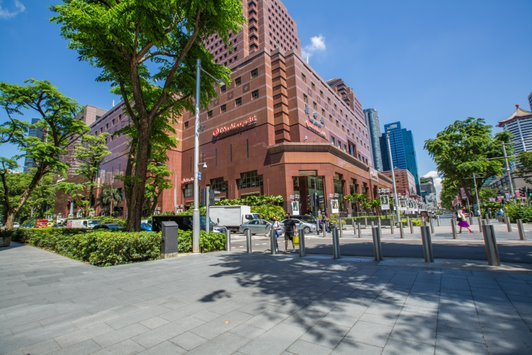
An image of Takashimaya by our photographer.
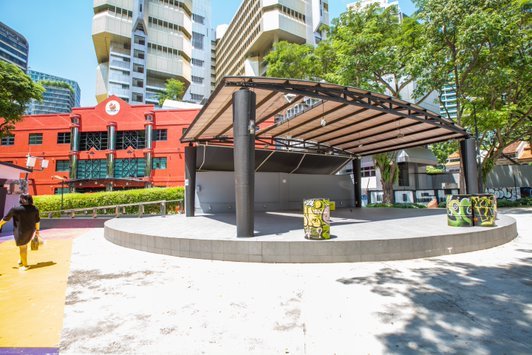
An image of the Youth Park performing stage by our photographer.

A distant view of the Youth Corps Red Box.
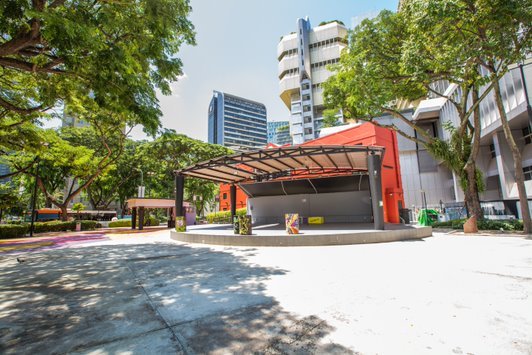
A Distant view of the Youth Park performing area.

A Shot of the skate park.
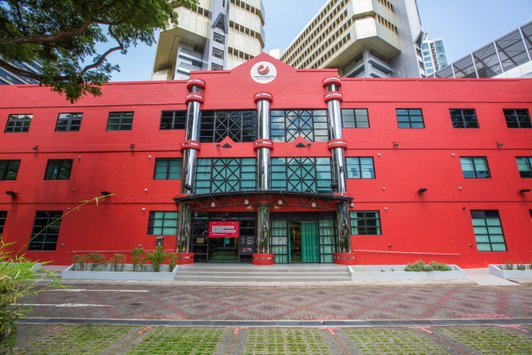
Red Box View

The Art mural located at scape

Image of SCAPE Entrance

An image of Scape’s Bandstand.
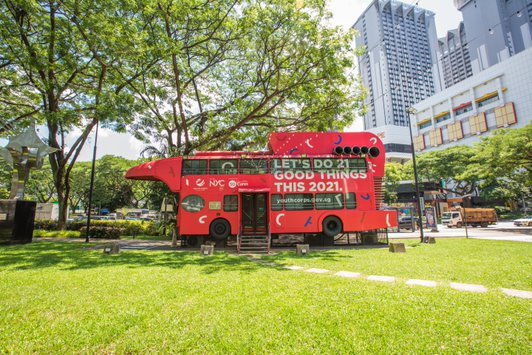
The Trailer of Brahmastra Festival of Arts and Music 2021 (VR)
There were 2 main streams of workflow at this time. While I was planning out the artist lineup for the performance, Dexter had started to sketch the somerset belt images. By Mid June, we had planned our main artists for the festival while Dexter had completed his 2d sketch of somerset belt as seen below.
Artists (Main lineup)
- Brahmastra Collective featuring Chris (Multi-Disciplinary Project)
- Motus (Latin Contemporary Street Percussion Group)
- Sri Waran (Malay Traditional Dance)
- Bhaskar Arts Academy (Indian Traditional Dance)
- Gendang Akustika (MalayTraditional Fusion Ensemble)
- Open Score Project (Multi Cultural Music Ensemble)
The 2d sketch of the somerset belt is located below for your reference.

A 2d sketch by Dexter Fang.
We then started our hiring process for interns to assist us with the modelling and texturing of the model. We had then selected 2 interns to start the project.
The team had started converting the individual units of the sketch to model. The process is shown in the images below.

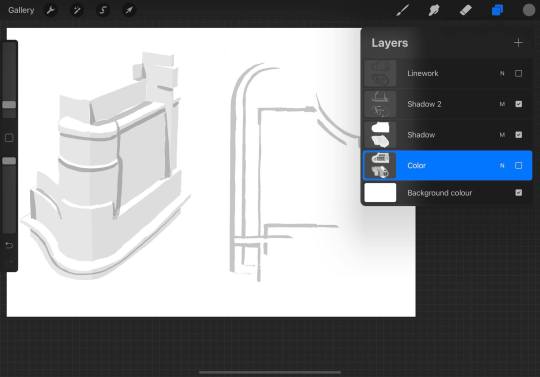
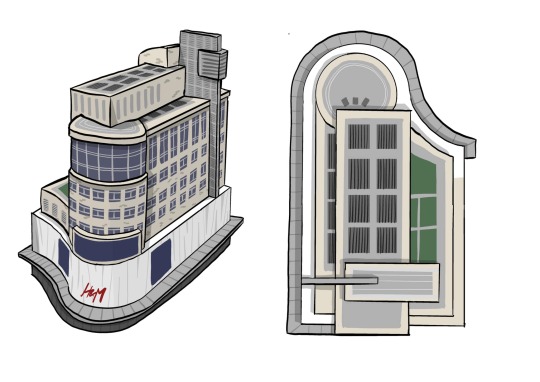

The development process of one of the buildings located within Somerset Belt using Maya.
A draft sketch and conceptualisation was also done by the team so they sync up the art style of the model. A sample of the conceptualisation is located below for your reference.

The conceptualisation of Cathay Cineleisure.
The team had also started designing the road assets required for the model such as buses, cars, lorries and vans. Some of these assets are located below for your reference.
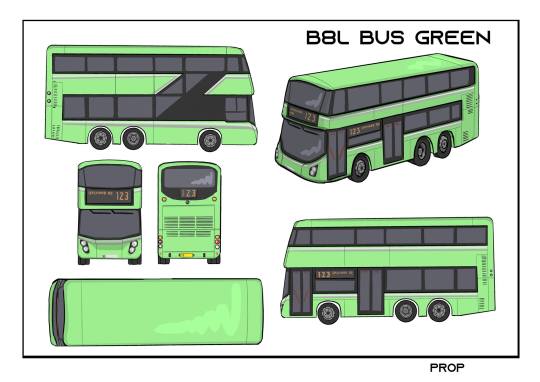
The different perspectives or views of Singapore’s bus.
By the end of the month, the building assets were modelled as we have seen some of these assets. We have also finalised the artist lineup for the main team and have locked the artist down for the filming of their performance to be on the end of June 2021.
But, with covid restrictions, we had to shift our shoot to the month of July 2021. i had postponed all my production meeting to the next month.
We had also conducted an open call for artists and musicians islandwide. I have located the brochure that was designed by my team for the open call.
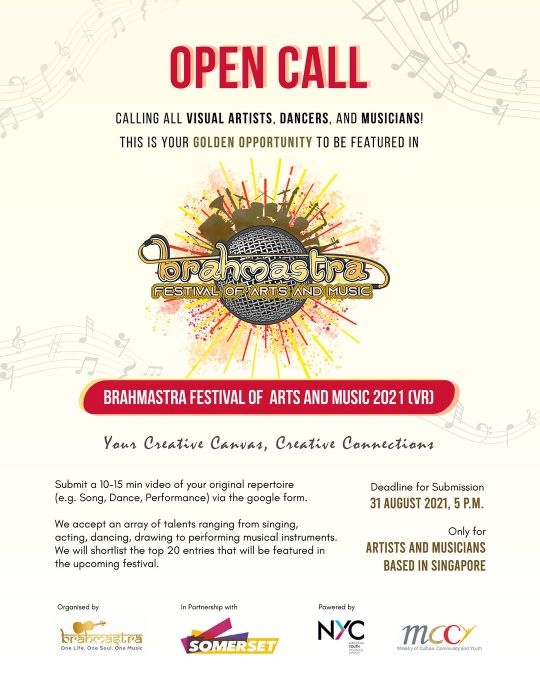
Open Call poster for the Brahmastra Festival of Arts and Music 2021 (VR)
Challenges:
1. We needed more manpower to develop the sketches into models. We also needed to focus on single art style of the map. Additionally, there were a series of communication breakdown between myself and the head developer of the model.
2. At this point of time, we needed to think ahead by planning which of these buildings are we going to scope into and develop them in our models.
3. Our interns were not also contributing effectively to the project. The planning of the project was not sorted and needed to be addressed.
Solutions:
1. I scheduled a meeting and laid down the objectives if this project. I had also specified the roles of each and everyone as well as the timeline of the projects. We had then created whatsap groups to start liasing the various workflows. The interns were liasing with MCCY alongside me and the model developers were constantly working on the creation of the model.
2. I also established conversations that generated more perspectives and approaches to this project. I learnt a lot by listening to my team members and while implementing some of their initiatives.
Discoveries:
1. I discovered the importance of effective communication. I learned techniques to converse with people from all walks of life. I also listened to them carefully with a very open mindset. This allowed me to learn new perspectives and thought processes from my team members.
2. I discovered the role of team leader to direct and manage resources while integrating various workflows. I also constantly learn from such workflows while I adapt my thought processes along the way.
JULY 2021
In this month, we had progressed to complete the fundamentals of the model. We had heard news that our filming has been cancelled again and we decided to focus on getting the model ready first.
The team continued pushing on to generate the assets for the models. Some of the assets are located below for your reference.
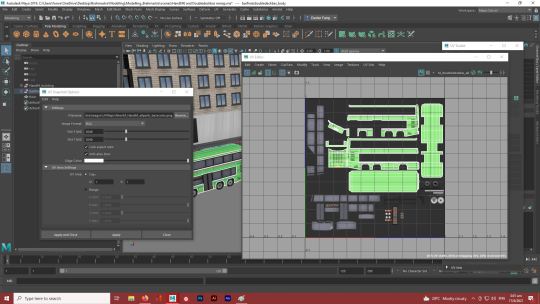
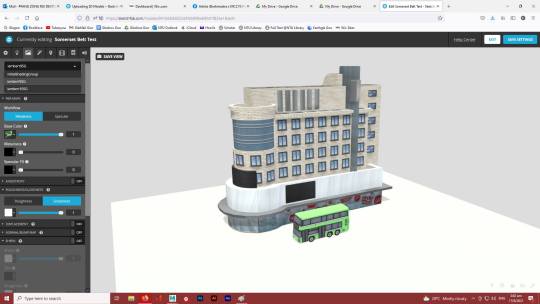
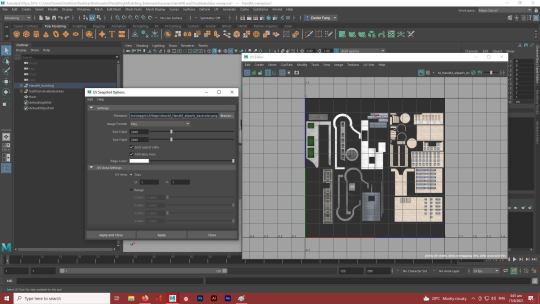
These images are with reference to one particular building and this workflow was applied for all the buildings and vehicles.
Some images of the other vehicles are located below for your reference as well.

A Sample view with the modelled bus
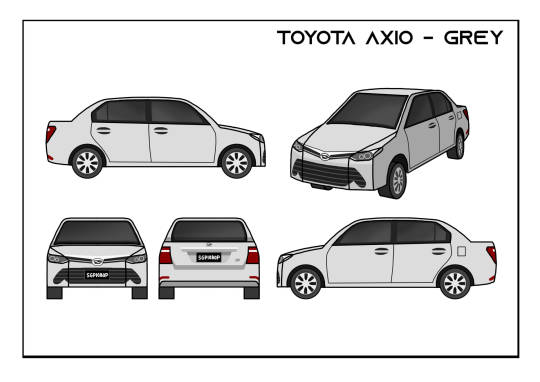

With these aspects in place, the team went to put on all these assets onto sketchfab, a recognised platform for our website. The sample of the model is located below for your reference.



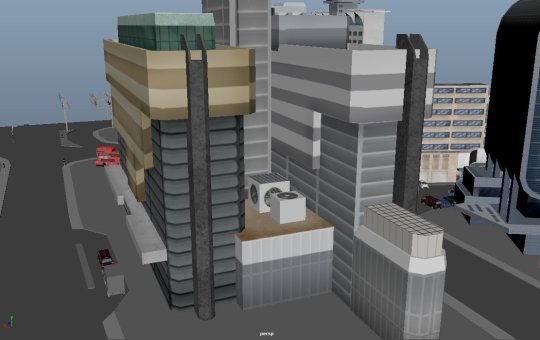
As the model was coming to live, the team focused on syncing up art styles and start to generate street assets such as the roads, lights and the street signs.
I conducted a production meeting with the video team on planning for the upcoming filming session. I had appointed my video director to setup a team for the production. I was also requested to book the venue for the filming namely Skate Park, Youth Park, Scape Dream Studio and the Band Stand.
Some of these application process was too extensive and required me to secure my own set of electricians to sanction my proposals. i realised those were out of scope of my filming project and decided to make do with venues that are less stringent.
Due to covid restrictions, our filming got postponed to the end of August 2021. We still prepared the administrative documents for the shoot. I have located images of some of the documents that was used for the production below for your reference.
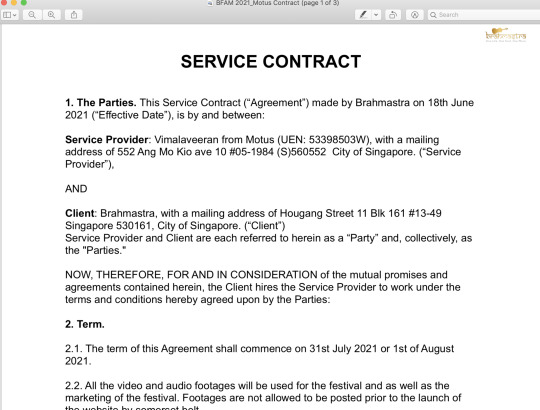
We had issued service contracts for all our artists and musicians who were part of the main performance team.
We had also collected all the bios from the musicians and artists for marketing and to include them onto our website later on.
We also collated all the tech rider information from the respective groups and updated my sound team for the filming. I have attached a rough copy of the tech rider of an ensemble in this blog for your reference.
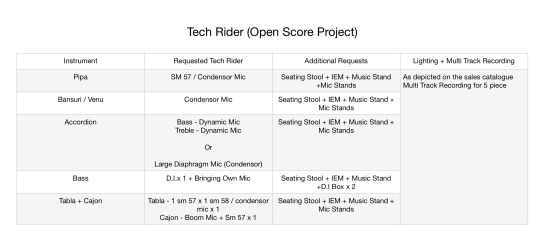
Tech rider for Open Score Project for their filming at the Dream Studio located at SCAPE.
With the confirmation of the venues by National Youth Council and SCAPE, we then locked down the video and audio crew for the shoot. We finalised the date of the shoot to be on 31st July and 1st August 2021. I had setup a production schedule and briefed my team on 16th July 2021. I have located the tentative production schedule below for your reference.
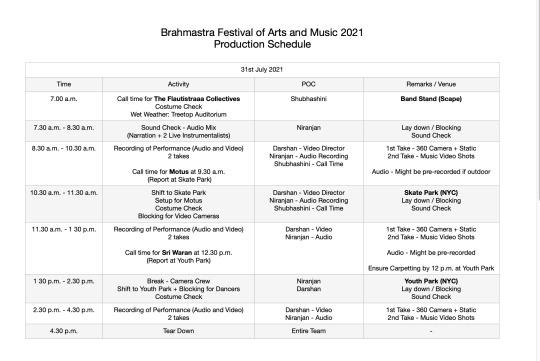
A tentative production schedule for Brahmastra festival of arts and music 2021.
We had also planned the stage layout for the acts. The stage layout for the performance by Gendang Akustika is located below for your reference.
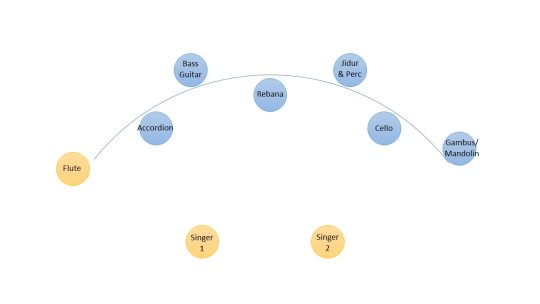
Stage Layout for Gendang Akustika.
We then filmed the musicians and artists over the weekend with IMDA and safety regulations in place. Below are some images and videos of the production.
We started with our first Act: The Brahmastra Collectives featuring Chris
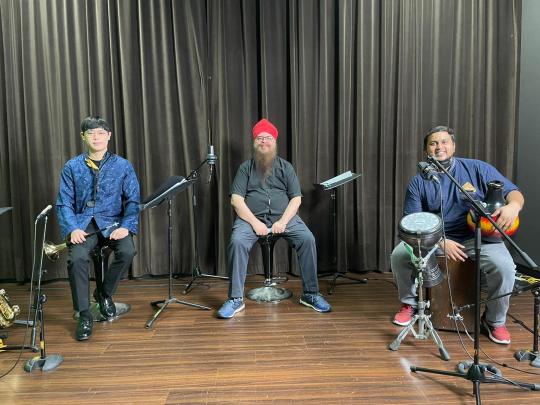

Some of the photos taken during the video and audio recording at Dream Studio at Scape.
They had presented original poems and improvised music for this segment. We had them perform 2 sets and we covered the audio recording and as well as the video recording containing the master shots and the close ups.
It had then started raining and our plan was postponed to a later timing, Despite the challenges, we proceeded with the recording of the second act at an indoor location namely The Red Box Auditorium.
With numerous challenges from a torn roof to the relentless rain, we completed the shoot on Sunday. Some of the BTS videos of the shoot are located below for your reference.
youtube
BTS Video of the preparation of shoot of ACT 1 of Brahmastra Festival of Arts and Music 2021 (https://www.youtube.com/watch?v=87dbEoh7LqQ)
youtube
BTS Video 2 of the preparation of shoot of ACT 1 of Brahmastra Festival of Arts and Music 2021 (https://www.youtube.com/watch?v=1FOunZQLSVM)
youtube
BTS Video 3 of ACT 2 of Brahmastra Festival of Arts and Music 2021 (https://www.youtube.com/watch?v=qIggwzBOi4s)
youtube
BTS Video 4 of ACT 3 of Brahmastra Festival of Arts and Music 2021 (https://www.youtube.com/watch?v=wEzH_Ew3Ngs)
BTS Video 5 of ACT4 of Brahmastra Festival of Arts and Music 2021: https://www.youtube.com/watch?v=DVxQl51nIXM
BTS Video 6 of ACT 5 of Brahmastra Festival of Arts and Music 2021: https://www.youtube.com/watch?v=2UfV5tLlp3w
BTS Video of ACT6 of Brahmastra Festival of Arts and Music 2021: https://www.youtube.com/watch?v=2urXh42kd1w
I have also included some of the images taken during the shoot for your reference.


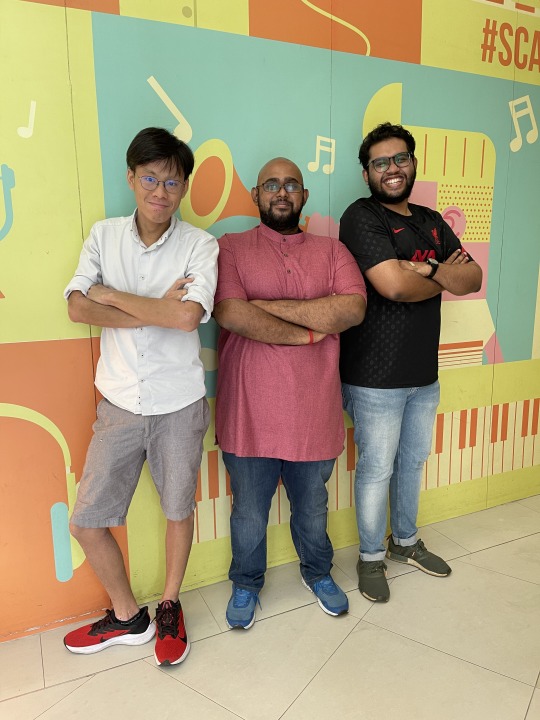
The main crew behind the Brahmastra Festival of Arts and Music 2021.
The video was then sent out for post production and the audio will be mixed and mastered by me during the month of September 2021.
Challenges:
1. Modelling: The timeline was getting tighter and we needed to expedite the modelling process and start integrating them into and external application that can be hosted by the website.
2. I had a hard time developing the service contract as the references I had was indicating different clauses. Some of the artists were not agreeable with the service contract and I had to adapt some of the clauses of the contract. One of the organisations had requested us to take full responsibility of the health risk of the participants.
3. Our location partners were one of the biggest challenges of the project. The communication between Youth Corps and *SCAPE was slow. They also required us to fill up too many forms. This was the case for *SCAPE as they had requested us to even source our very own electrical engineer for the use of the venue. This was beyond the scope of the project. Additionally, *SCAPE was not giving us any alternatives to venues. It was a very negative experience dealing with *SCAPE.
4. We also had issues with the operators of the DREAM Studio, a facility owned by EBENEX and managed by *SCAPE. The sound engineer was non accommodative and extremely rude to my production team and members. He was giving the crew members attitude and stares throughout the session. This impacted the team very negatively. This issue was coupled with the engineer had sent me extremely bad quality audio samples with white noise in 2 of the mics. I was extremely disappointed with the quality of service by EBENEX and *SCAPE.
5. We had also failed to plan wet weather plans as the wet weather plans delayed us by 4/5 hours resulting in incurring a higher production cost.
6. Strict adherence to the Safety Management Measures added more strain to the team as only a limited size of the production crew was allowed to be part of the audio and video recording.
Solutions:
1. We met together as a team and laid down certain timelines. We also derived a certain set of action points and worked on completing them before the month of August 2021.
2. I sat down with my friend who is a law student at the Singapore Management University to design the service contract for the performers. We also had a meeting with our partners to negotiate the terms and conditions.
3. We decided to drop the planned locations as they were not helpful with supporting us. We used a few locations belonging to youthcorps. We had to also change to other locations as the heavy rain did not allow us to film at the outdoor locations.
4. I had provided feedbacks to MCCY and decided not to pursue further recordings with DREAM Studio as they had offered to re-record the musicians. This will cost us more. Therefore, we made do with audio samples we had and laid down more production layers to cover the poor recordings by EBENEX.
5. The rain had led us to shift our gears to an indoor shoot where the acoustics and space requirements of the performance were limited. We could not cancel the production as well. So we decided to shift into an indoor location and continue with the shoot. We extended our shoot times and thus the cost of production.
6. With a limit of 20 pax which was notified to us by Youth Corps, a week prior to the shoot, left us strained with limited pax. We were all doubling roles and had to help each other out. I was handling both the management and the audio equipments for the production. I was also recording audio for 2/3 groups. I learnt to multi-task and so elated to have completed the shoot.
Discoveries:
1. I discovered how certain organisations are not inline with my efforts and aspirations. It was saddening but I overcame these with the help of wonderful officers from MCCY. There guided me through the challenges by offering additional insights to my workflows.
2. I also established good friendships with my audio and video team. I also learnt about their perspectives during the production.
3. I discovered the need for wet weather plan management and have started incorporating that into all of my outdoor shoots.
AUGUST 2021
In the month of August, we were shifting our focus into confirming the remaining acts of our performances for the festival. We wanted to feature not only traditional and contemporary arts and music practitioners but as well as community based collectives and CCAs from across the island. We then shortlisted the following artists for the showcase. The lineup is showcased in the brochure that was released in the month of October 2021.

The images depicts the event poster for the Brahmastra Festival of Arts and music 2021.
The performers are from different ethnic backgrounds and I had a great time curating these artists.
By the end of August, we had also finished developing the map and we had integrated the map from an external plugin onto wixsite. The link of the website is located below for your reference.
https://www.bfam.online/
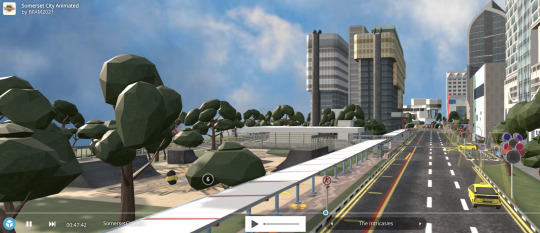

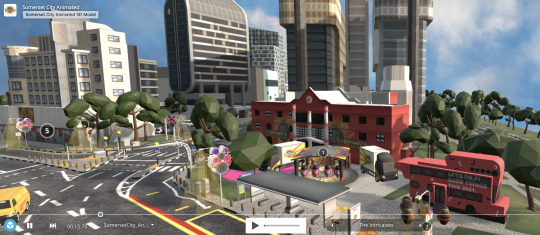
Screenshot of the model that was integrated into the official festival page.
I had also composed the official track for the festival named “Union of Aesthetics”. The sample of the song is attached together with the official trailer of the festival located at the very top of this blog.
The stems were then sent to Rahmatullah, my sound engineer for the festival for a good mix and master of the tracks. We took the last week of August to work on these. The following image contains the screenshot of the session for your reference.
IMAGE REFERENCE OF BFAM 2021 SONG
Once these assets were completed, we proceeded to the next phase of this project. As the media team is busy with post production for this festival, we started the marketing phase for this project. We had prepared the press release and got in touch with a few marketing companies and media platforms to showcase our festivals. This segment happened between the month of September to November 2021 which is out of scope for this blog.
Challenges:
1. The covid restrictions kept changing.
2. I needed to get better with curating acts.
3. It was extremely difficult to balance different roles of this project. Though it was an extremely wonderful opportunity, it took a very large toll on me.
Solutions:
1. We needed the mental resilience to keep adapting to new regulations and safety measures. I had to keep checking for the updated set of SMMs so I can be always making quicker decisions.
2. I realised that my curatorial process was based on contacts and not based on concept. Though I had a concept in mind, I did not stick by it till the very end as the outcome did not turn up as expected. The application for the open call was too low and survived with the use of world of mouth. I had to streamline my open call and make the process more effective and accessible to our community. Despite sending out the email to numerous institutions islandwide, less than 10 got back to our open call.
3. I needed to delegate more while expand my network. I will be working on this respect.
Discoveries:
1. I learnt how ruthless organisations can be. I learnt coping mechanisms and always remind myself not to take these aspects personally.
2. I discovered new friendships and memories. I will be adapting some of the strengths and limitations of this workflow to my upcoming productions and performances.
0 notes
Text
SEADOM 30 under 30 Opening Seminar
I was selected to be one of the representatives of Singapore for the 30 under 30 programme initiated by the South East Asian Directors’ of Music. This seminar was conducted on 14th August 2021 via Zoom led by Dr Anothai from Princess Galyani Institute of Music and Dr Khoo Hui Ling from Yong Siew Toh Conservatory of Music. I was discussing about the wonders of musicianship and as well as the beauty of being a touring musician.
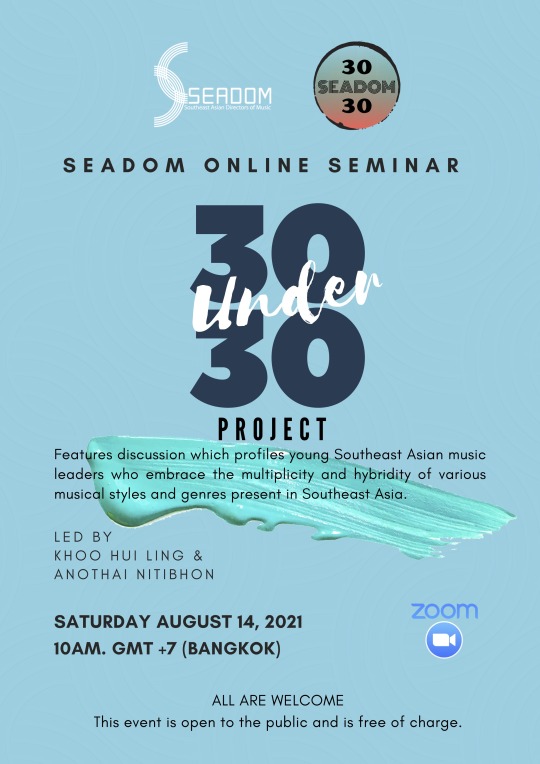
The brochure for the seminar of the 30 under 30 project which was open to the public.
I shared about my perspective on musicianship and how I embrace ever learning. I spoke about my journey in music and how I always treasured the moments I had with my co-artists. More than being able to tour and perform with musicians, ensembles and orchestras around the world, it was the friendships and the moments that mattered a lot to me. I shared some of those experiences in the seminar. I also spoke about how I have started embracing technology into music through my productions. I was also given the opportunity to showcase some of my projects in the seminar.
I also learned the following aspects from my co-speakers:
1. Finding the right balance between business and music. This was a very difficult facet for me but I had learnt a few hacks such as learning how to balance the commercial elements while working on musicianship.
2. I also learnt some music training and education pedagogies from a few music educators who were part of the panelists.
3. I learn how orchestral musicians have embraced their roots and traditions in their compositions as some of the panelists showcased some of the beautiful compositions. I t was really inspiring.
This seminar was a great experience and it had connected me to souls from the 10 ASEAN countries. I have also learnt a lot from my co-artists and panelists. A screenshot of the session is located below for your reference.

Challenges:
1. It was challenging to articulate my thoughts clearly. It was a long time back where I spoke to a large group of people. Being on an online platform did not help me with getting better with public speaking.
2. I tend to be long winded with my points and I was speaking too fast
Solutions:
1. I started to talk out loud at home and practice speaking to myself before conventions and workshops. I also referenced the following materials to better my public speaking skills:
- Breaking the habit of being yourself (https://www.scribd.com/audiobook/332600811/Breaking-the-Habit-of-Being-Yourself)
- TED's secret to great public speaking | Chris Anderson (TED's secret to great public speaking | Chris Anderson)
- How to talk to anyone? (https://www.scribd.com/audiobook/393343936/How-to-Talk-to-Anyone-Learn-the-Secrets-of-Good-Communication-and-the-Little-Tricks-for-Big-Success-in-Relationship)
2. I started planning out my points out before the presentation. I had used these techniques for the dissertation pitching session.
Discoveries:
1. I discovered some methods of engaging the community by asking rhetorical questions when I am on a face t face setting. Some other techniques include the concept of being relatable and telling stories through conversations.
2. I also discovered the lack of confidence and mechanism that helped me strengthen it. The mechanism involves the use of perspectives and always defining my identity as practitioner of music.
0 notes
Text
Connecting Trailblazers by Sinda Youth Club and Tamizha
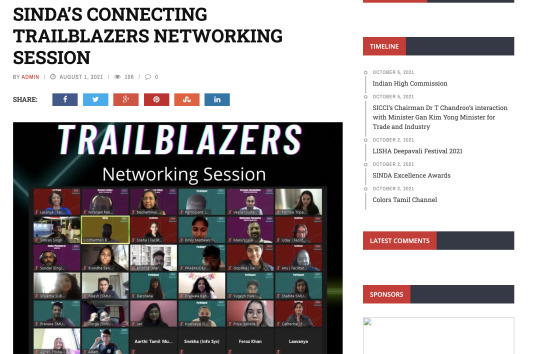
I seeked this opportunity when I saw an open call for participants for the Connecting Trailblazers networking session. While applying to be part as a participant, I had also requested if I could present on the wonders of the music fraternity as they had not planned a segment covering Singapore’s creative industry. I received a return mail saying that they would love to have me as part of their panelists. The networking session happened on 17th July 2021. This blog speaks about some of the issues discussed as a creative artist in Singapore.
Some of the issues that I had discussed would include:
1. How do we create opportunities if we do not get many coming along the way?
2. The need for having a career plan is important to be successful in any given job.
3. Planning you live, your career is an important aspect of life.
I shared on how I started out as an artist and how my interest in music was sparked as I watched artists and musicians around the world. I also spoke about how the flute gave me a purpose and identity in life. It was an inspiring session as I had also learnt a lot from other industry speakers.
Some of the lessons would include:
- Workflows are important and it is always good to keep refining them.
- Always look ahead and plan ahead. Plan for contingencies as well.
- I also learnt about the wonders of not thinking about yourself but for the collective.
The networking session allowed me to connect with people from different walks of life and as well as students from other institutions. I also realised how a lot of the panelists were talking about the importance of goal setting and planning for contingencies. These were lessons that I have incorporated into my own core system.
Challenges:
1. There was a lack of understanding from the participants on the requirements and different roles in the music industry.
2. There were generalisations made during the session by the participants.
3. There was a tinge of disdain from the participants as I was representing the creative industry amongst other panelists who were from the banking, law, science fraternities.
Solutions:
1. I showed them workflows that were involved in the productions and drew parallels to other workflows from across fraternities. I showed them how the ethics of the workflows are preserved just that the type activity and transactions involved changes in accordance with the type of industry.
2. I also spoke about the meaning of conviction and how it is important to change the perspectives about Singapore’s Arts and Music industry.
Discoveries:
1. I discovered the extent of my conviction with music. Music has been a large part of my life and it was demoralising at start to experience disdain and misinterpretations from the community. With conviction, I realised anything is possible.
2. I also learnt about other workflows and how they operate in the medical facilities distribution line as well as the workflows pertaining to the banking industry. It was intriguing to learn and adapt some of those workflows into my productions such as the setting up of an auditing team and a finance department to plan budgets and performance reports. Hopefully, we can grow to include these departments into my company.
0 notes
Text
The Inner Urge (EP)
youtube
I was inspired by the wonders of the Indian bamboo flutes and my relationship with my Indian bamboo flutes. I decided to document this in the music album. Firstly, I decided to plan out the narrative for the music album and the number of tracks that will be part of the album. I have documented the processes and the learning points while embarking on this music album between June to August 2021.
Pre-Production Phase:
I have planned to feature 4 tracks namely Desire featuring Gildon Choo (Pipa) and Jacky Ng (Suona), In Sync, Battle Cry and The Inner Urge.
Synopsis of the music album: Journey through the oceans and mountains with beautiful melodies on the bamboo flute by multi-award winning indian classical flautist, Niranjan Pandian. Every note and every breath will make this journey surreal. Take a deep breath and dive in.
Desire - This song features Singapore’s multi-ethnic instrumentalists Gildon Choo on the Pipa and Jacky Ng on the Suona. The song is composed in Raga Hamsadhwani following an regular pop arrangement.
In Sync - This composition is inspired by the relationship between the. mind, body, soul and the heart. That intricate connection is musically showcased in this composition. The song is set to Raga Bageshree, one of my favourite ragas from the Indian Classical music systems.
Battle Cry - This composition is about the internal war between my heart and my mind. This conflict and the resolution is nicely captured in this composition. This is composed in a Dorian scale and in Raga Sri.
The Inner Urge - The center piece of the music album. This composition talks about that inner search for peace and tranquility as I struggle through life while finding the purpose of my life.
With these narratives, I started piecing the compositions together. I followed my conventional way of composing music. I started with the melody and then started building the rhythms and as well as the harmony around the melody. After which, I started arranging the piece to include the other musical components. The screenshot of the initial session is located below for you reference.
Once the arrangements have been planned, I have started generating reference tracks, the session tracks and the lead sheets for the upcoming recording session.
The sample lead sheet is located below for your reference.
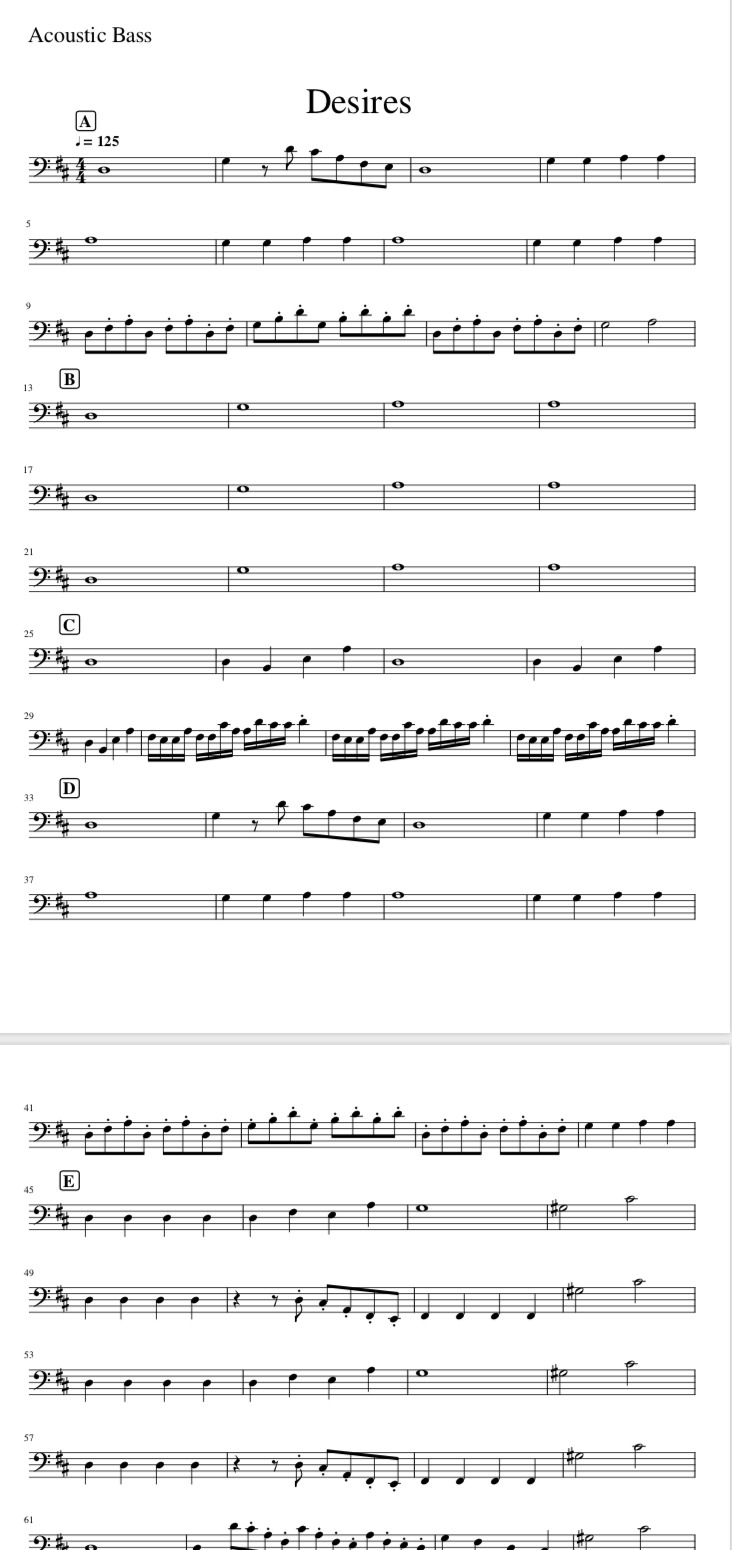
Acoustic Bass score for Desire, one of the compositions for The Inner Urge music album.
Once the pre-production materials were prepared, I disseminated the google drive link containing the reference tracks, session tracks and the lead sheets to the recording artists prior to the recording session.
Challenges:
1. I realised that my workflow is rather inflexible especially when the timeline for a project is tight.
2. I failed to plan properly for contingencies.
3. My arrangement of the songs were weak and needed more work and research.
Solutions:
1. I adapted a new workflow for this production. I generated the lead sheet and the reference tracks for session musicians. I also consulted my sound engineer on methods to speed up the upcoming production process.
- Conduct multi track recording of instruments playing similar roles for the track.
- Submit the scores and reference materials for the session musicians before hand.
- Prepare alternative parts if the instrumentalists cannot play the assigned parts.
2. I quickly retrieved contacts and placed them on stand by for contingencies. Such contacts include recording engineers, music studios and marketing personnels.
3. I was constantly reflecting and referenced the books mentioned in the prior section. I had re-worked some of the arrangements to better showcase the narratives that I had in mind.
Discoveries:
1. I discovered time effective workflows that were flexible. The workflows allowed me to plan ahead of time while plan for contingencies.
2. I looked up on arrangement techniques and consulted friends from the music arrangement fraternity. I learnt the intricacies of arranging for ethnic instruments. Though I could not actively apply for this project, I have made notes and will be implementing the lessons learnt here in the upcoming production.
Production Phase:
We planned the recording schedule for our artists namely the Accordionist, Pipa, Suona, Oud, Acoustic Bass, Percussions and the Indian bamboo flutes. We had also planned the recording studio and locked the venue. The screenshot of the recording schedule is located below for your reference.

Recording schedule for The Inner Urge music album.
With the assistance of the recording engineer, Dale, we had recorded all of the above mentioned artists and musicians. I had directed the music and ensured that the musicians recorded all the sections with the intended artistry and musicianship. There were some sections where the musicians couldn’t play the sections due to the limitation of the instrument. The photos taken during the recording phase have been located below for your reference.

Recording of the string sections for one of the songs of the EP. Dale was assisting us with the mic-ing of the instrumentalists as well as the recording of the musicians. I was directing the music and ensuring that the intended musical expressions of the compositions are met.

In this session, we recorded the wind section for the album. We recorded the suona and the accordion for the track, In Sync and Battle Cry. I had to learn the intricacies of the suona and only managed to learn more about the scale range of the suona after the completing the pre-production process.

In this recording session, I was recording the Acoustic bass. I was learning on various methods to track the acoustic bass as a series of mic-ing techniques were used namely the use of condensors and as well as the use of the room mic.

In this recording session, I was recording the mirdangam and the rebana for my compositions. One room mic was used to collectively record them while individual mics were used to obtain their individual stems.
I then collected all the audio samples and started layering them with my production layers. I have attached a screenshot of the session when I was merging the recorded samples with my production layers.
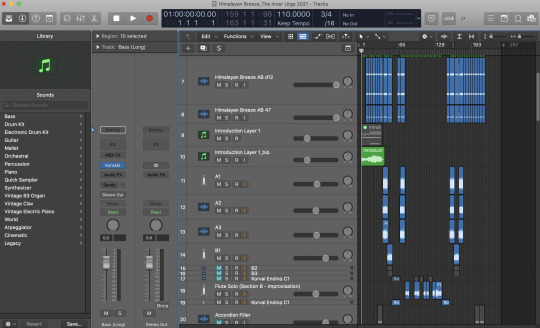
The screenshot of the session when merging the Acoustic bass layers with the bass production layers.
I had then spent a week cleaning up the session. Though the timeline was tight, I had to push through by obtaining an ideal combination of the recorded musicians and the produced layers. This took a lot of experimentation and importantly, patience. After a week, the layers were cleaned up and prepared for handover to the mixing and mastering engineer.
Challenges:
1. I was losing my stamina especially during long recording sessions. I needed to build my stamina so I can more effectively guide my musicians and artists.
2. The timeline was too tight for the musicians to sight read and perform as expected but I was touched by their efforts and dedication to the music.
3. Some of the musicians were master sight readers whereas some of them were strong with their listening. I failed to understand that some of these musicians were slower with reading and required alternative notations such as the Carnatic music notation. I should have prepared these materials before hand as this factor resulted on more time spent at the studios.
4. A few of the musicians were only learning the compositions during the recording session.
Solutions:
1. I was seated through 6/7 hours of recording in a single seating. I should have planned breaks in between these sessions to further optimise my work. I will ensure that I take breaks every 1/2 hours and not burn out by the end of the session.
2. The timeline was too tight for the musicians to sight read or learn the compositions before hand. I could have submitted the reference materials ahead of time. I will work on these aspects and it will get better over productions.
3. I embarked on creating alternative scores for musicians. I included the following set of notations for musicians: staff notation, indian classical music notation and reference guides.
4. Some of the musicians lacked discipline as some of them did not prepare their music. I was utterly disappointed with these musicians. I had noted and decided not to have them in my future productions. Their irresponsibility had led me to incur a higher cost.
Discoveries:
1. I discovered the need for planning as certain form of contingencies had helped me save time, cost while keeping to the scope of the project.
2. The adapted workflow in this instance was favourable as I was able to complete the entire recording process in 1 week.
3. I also discovered the wonders of alternative notations for musicians. I realised how musicians read music differently and thus providing resources in accordance with their strengths. This will optimise the objectives of the project.
Post Production:
The post production phase of this project offered me numerous learning points as well. I was working closely with the mixing and mastering engineer to get the best of the 4 tracks. We were exchanging feedback for one week before we settled in for a mix. We then prepared for the release of the EP with believe music international. I sent out the tracks for vetting by my liaison and later added it to the backstage.
While preparing for the release, I had to also design an album art cover and promotional materials for the EP. I had used Canva design to help me with some of the marketing materials. The screenshot of my process is located below for your reference.

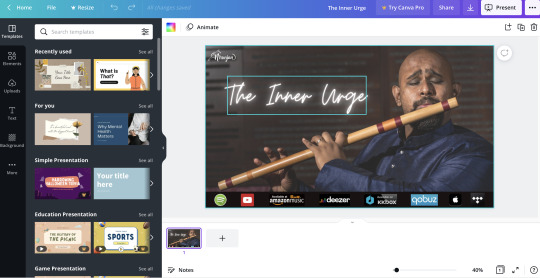
I had spent a few hours designing the collaterals for the EP release.
I have also reached out to a few media and marketing platforms to assist me with my launch namely Bandwagon and Hear 65. There were a few rejections from numerous companies and I was constantly reflecting on these aspects and the gap in my marketing strategies.
The song was listed on Bandwagon as shown in the link below.
https://hear65.bandwagon.asia/albums/the-inner-urge
Challenges:
1. It got tiring and daunting when local media and radio stations fail to recognise your work and always did not return with any form of email or notification stating the reason for not including my work as a showcase.
2. I always looked and learnt workflows and always thrive to make workflow more effective. There was a tinge of pain when my songs were not given large credits. There were too many factors that could affect these.
3. I had sent the tracks to a few of my friends and artists across the globe and received both positive and negative feedback. I took both and learnt from those feedback.
4. It was inspiring to see an entire production come to live but sometimes, I think the masses do not understand the workflow and the effort gone behind a lot of such works. Hopefully, these aspects change over time as I keep refining my role as a music composer while bridging different communities around the world through the wonders of music.
Solutions:
1. I am keeping at it as I build a team of musicians and artists together. Though there is a lack of media coverage, I am hoping to touch people’s lives. It will never be about me but rather the experiences and perspectives of my community.
2. I identified reasons to why my songs did not reach the local community. I learnt that I needed a stronger form of marketing and will be pursuing this as I partake more productions.
3. I had taken the comments from the community and developed an action plan for my upcoming album launch in November 2021.
4. I continue connecting with genuine people while creating memories with such people. I orientated and directed myself into such a thinking as a coping mechanism to the lack of apathy from the community.
Discoveries:
1. I discovered alternative workflows and how I could optimise the objectives of the project by creating new music reading options as well as by studying the strengths and limitations of the musicians.
2. I discovered the amount of work to be done to surpass the apathy from the community. I also realised the wonders of creating memories. The memories kept me going and made this project a pleasant experience after all.
0 notes
Text
ASEAN Traditional Music Challenge (C Asean Consonant)
In this segment, I will document my experiences with arranging music for a multi-ethnic ensemble for the ASEAN music contest organised by C ASEAN Consonant. The performance video was premiered on 8th August 2021 in conjunction with Singapore’s National Day Celebrations. The production is located below for your reference.
youtube
The music video showcased some of Singapore’s melodies as well as wonderful musicians across ethnicities and fraternities namely Edmund Song (Acoustic Bass), Murale Naidu (Cajon), Aliff Azman (Accordion), Gildon Choo (Pipa), Haripriya Sreenivasan (Mirdangam) and myself on the Indian Bamboo Flutes.
There were numerous limitations for this production which includes a limited budget and unclear intention of the project.
Pre-Production (Audio and Video)
I sat down and plotted the timeline for the project. With the limited budget, I had seeked out the expertise of my production crew as well as the featured musicians. With the available artist lineup, I selected the following songs to be showcased in this production.
Xin Yao Medley, Muneru Valiba, Chan Mali Chan and Home.
I took 8 hours to re-arrange the components for the recording session and planned the recording session for the artists. I also had to book Noivil Studios for the video recording of the music video.
Production (Audio and Video)
The Audio production took 9 hours in total. I had invited the artists to my home studio and recorded them. After which, I had to layer them and clean up the session. I had also recorded the narrator, Ajay Govin for the performance. I was also applying mixing and mastering techniques taught during production class. This was then released to the music video producer, Darshan to start the pre-production work for the music video shoot.
The video production took around 4 hours at the Noivil Studios. We then shot the entire music video and sent it out for video editing.
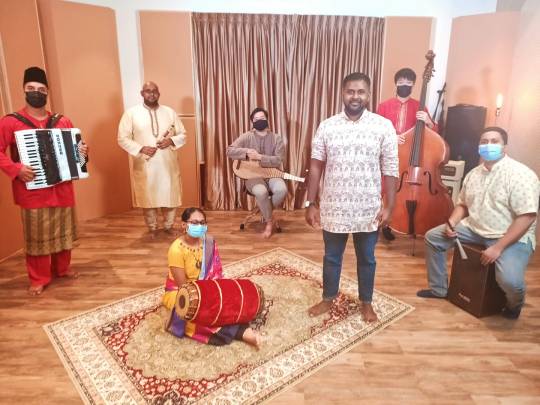
The scope of the project changed when the client mentioned that the performance needs to be presented in a documentary style. I had to record my parts with the narration describing the processes as well as the instruments involved in this performance thereafter.
Challenges:
1. I had to re-arrange National day songs and I could only re-arrange in the ways that I was comfortable with. This was one area that I needed to work on.
2. I needed more understanding of the instruments as well as the scope of each of these instruments. In this way, the arrangements would have sounded fuller and richer.
3. Recording Techniques: The vocal parts towards the end was clipping and I failed to address them. The flute components were also not recorded effectively.
4. Production Techniques: I had also tried to mix and master this track as there was a lack of funding for this project.
5. There was a lack of funding for this project and had to look for collaborators for this performance. This inevitably affected the scope of my project.
Solutions:
1. I need to revisit some of the re-arranging techniques. I could only do this after the project as the tight timeline did not offer me space to study and apply the concepts immediately. I soon embarked on this before I started work on future productions.
2. Recording Techniques: I needed to experiment with more possibilities and combinations. I also needed to invest in more mics for the upcoming productions. Due to time constraint, I had only record one layer of the flute and produced the flute as a performance layer.
3. I am still finding it difficult to balance aspects of producing a show, composing or arranging tracks with performing on the Indian bamboo flutes. I have a workflow that I have learnt at LASALLE and I have been actively adapting the workflow across projects.
4. I applied production techniques that I learned during Hector’s class in this project. I started out getting a good mix by center-ing the layers while cleaning up the frequencies. After which, I was mastering the tracks by using plugins such as the multipresser and the adaptive limiter. There are a lots of room for improvement but I was thankful to have received this opportunity to practice the techniques that I have learned in school.
5. One of the major limitations of the project will be the funding. I was given $500 to complete both the video and audio aspect of the project. This was a great struggle for me and I had to get collaborators on board. The collaborators included the video directors, videographers and the musicians. I was learning ways to manage such tight fundings. This approach was of help for certain projects where the funding was limited.
Discoveries:
1.I have found another way that I can adapt my workflow to address projects with a tight timeline. This was done as I delegated the coordination of the artists to my wife. She was assisting me with the coordination of the artists and musicians involved in this project.
2. I also explored different mixing and mastering techniques. I was more sensitive to sound as well as the mixing processes involved. I discovered my strengths and limitations of my processes as I received constant feedback from friends pursuing masters in production from Berkelee.
3. I also found the depth of collaborations and how I can effectively manage such collaborations especially when resources are limited.
0 notes
Text
Tamil Language Festival 2021 by Tamil Language Council
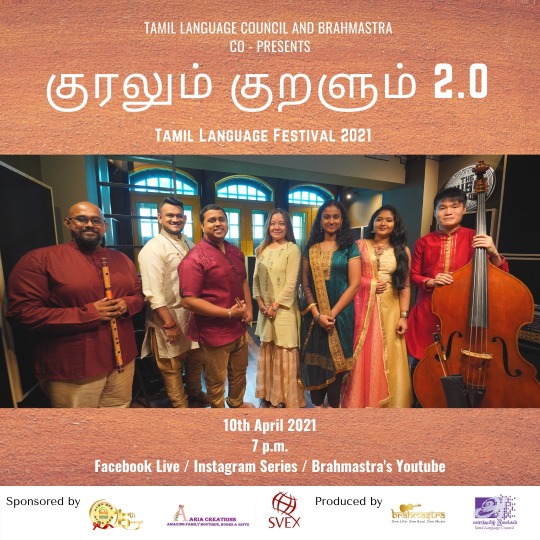
The Tamil Language Festival 2021 was co-organised by the Tamil Language Council (Singapore) and Brahmastra. The performance was released as a series of 6 songs on social media platforms such as Facebook, Instagram and Youtube with the aim of bringing Tamil language to youths. The performance was released on 10th April 2021. The performance videos are attached below for your reference.
youtube
This is one of the 6 songs that was featured for the Tamil Language Festival 2021.
This entire production was broken into 3 phases namely Pre-Production, Production and Post Production. We will look into how this project evolved across the platforms.
Pre-Production
We had a meeting with Tamil Language Council for the confirmation of the funding. This meeting took place via zoom in March 2021.
I also sketched out a proposal with the intention of bringing the wonders of Thirukural, a revered ancient hindu text closer to youths through social media platforms. The proposal also talked about how we can bring the meaning and the depth of the Thirukural with the use of modern music from the Tamil cinema industry. We will then be re-arranging the repertoire so that it matches the requirements of the organisers.
The proposal form (Screenshot) that was submitted to the Tamil Language Council has been attached below for your reference.


The following documents were submitted in preparation for the production.
I started with curating the songs for the performance and the scope of re-arrangement. I had then recorded the flute as the reference to start modelling the arrangement. A glimpse of the session for one of the songs is located below.

I had decided to do a single track recording and then execute post audio production for a music video style shoot. I headed the single track recording on the acoustic bass, drums, grand piano, flute and the main vocals. I also re-arranged the songs and orchestrated the various sections of the 6 songs.
After the recording phase, I had sent the tracks for mixing and mastering to my engineer, AR Rahmatullah. He had submitted drafts and we had constantly worked on the mix for about a week. We had ensured that the mix showcased the performance element of the music video and ensured that it did not sound produced.
This entire process took a week long. The mastered track was then sent to me for quality review before I had forwarded the final version to the video director, Darshan K for the creation of the storyboard for the upcoming shoot.
I assigned the various roles for the production crew and ensured that they work within the given timeline. I had a video director, 2 cinematographers and 1 editor for this production. I had then recce-ed and confirmed the Music Parlour for the production. I had then fixed the date of the shoot.
We also prepared to showcase one of our performances for the launch show by Vasantham, mediacorp for the Tamil Language Festival 2021. The following are some images taken during the launch.

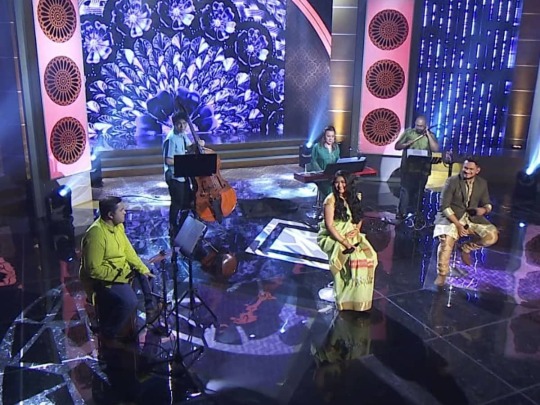
Production
We then filmed the production while the musicians mimed to the mastered audio tracks. The photo of the artists involved are located above for your reference. The production crew took 4 hours to film us and we were eagerly awaiting the output of the project.
Post-Production
We had a week to finalise the videos for review, for our client. We had a final meeting where we sat down and watched the flow of the project. We were not satisfied with the editing as the editor was new to the editing software. We did not have sufficient funding to get an editor on board. As we managed to rectify the issues and release the video to our clients, this project was well received by the community and by our client.
Challenges:
1. We had an extremely tight timeline for this project. Our deliverables were 9 song arrangements, 2 Video recording (One is for Vasantham and the other is for the concert) and 1 mix and mastered audio session file.
2. I was coordinating the artists and musicians, the video crew, the audio crew and the marketing crew for this project. The project flow was extremely hectic.
3. I lost control of the project the moment the project went over to the video side. Due to a lack of funding, we had requested a collaborator to help us edit the project. This became disastrous as the individual could not cope up with the work flow.
4. I realised I could have proposed a better budget and requested for an upfront deposit amount for me to orchestrate production costs.
5. With the tight timeline, the single track recording of the musicians consumed a lot of my time and I had to spend a lot of studio time recording the musicians as some of them were not used to reading scores.
6. I was learning to multi task between running productions, arranging music while playing the flute for the performances. My performance scope of the Indian bamboo flutes had dropped and I needed to find the equilibrium at the soonest.
Solutions:
1. I quickly delegated my job scope by getting my interns to oversee artist management while have a video director to oversee the video production of the performance. i was focusing on the music arrangements and the performance of the Indian bamboo flutes. This delegation allowed our workflow to be more effective and efficient.
2. The video editing was not well done and we could not rectify the project as the editor did not send us the source file for the production. We had then fired the editor and the video director had to edit the project. We then shortlisted potential editors for our future projects.
3. I could have used multi-tracking options which I have considered for the upcoming productions. During the mixing and mastering stage, there were some warping of sound waves which should have been addressed during the recording process. This could have sped up the entire audio production process.
5. Multi-tasking has become a necessity or a survival instinct. I have started partnering with more individuals and minimised micro managing. This will allow me to focus on music direction, arranging, post production and performance.
Discoveries:
1. I discovered the wonders of delegation in this project. I had then locked on to this team and we moved ahead with this workflow.
2. I also discovered a good working relationship between the video director and my audio engineers. I will be working more with this team for upcoming productions and performances.
3. I have re-strategised and will be using an alternative recording method such as the multi-track recording for such projects in the mere future.
0 notes
Text
Summer School: Teleprovisation
In this segment, I will share my experiences I had during the Summer School: Teleprovisation. This was an interesting experience and it has touched me at many levels. I have documented some of my experiences as well as the lessons learnt during Teleprovisation.
The Teleprovisation Summer School happened across two weeks and we were required to attend the programme from home with the use of online digital platforms such as Sonobus. I am thankful to the lecturers for supporting us with the tools required for the summer school.
I have summarised my experience into various phases.
ACTIVITY 1: 4 Artist Collaboration
Phase 1: Orientation Week
We were tasked to prepare a video introduction and register for a Distro account for us to communicate and exchange ideas with students from Tokyo and Zurich. We then recorded and produced our introductory film and linked it into Discord.
I submitted a Jazz improvisation component with the use of the Indian bamboo flutes as it showcased my current pursuit as an artist.
The following embed contains the performance that was submitted as the introductory video.
youtube
This performance includes a rendition of So Danco Sambo, a Jazz standard that I had learned during the ensemble class. I had adapted certain aesthetics of the composition into the Indian bamboo flutes. I have also improvised using certain inflections from the Jazz and Indian classical music systems.
During our first meeting, we were introduced to the workflow of the project and as well as the hardware and software required for the Summer school. The image of our first meeting that happened virtually is located below.
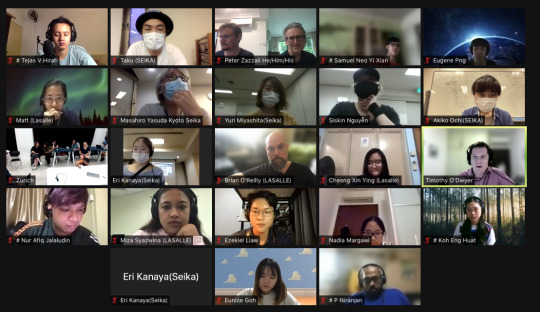
We had students from across fraternities within Lasalle College of the Arts as well as students from Zurich University of the Arts and Kyoto Seika University. We were first allocated our groups with whom we will be improvising with for the first session. This grouping is located below.

I was partnering with Queen from Zurich University of the Arts, Eng Huat from Lasalle College of the Arts and Siu Hei from the Zurich University of the Arts. We were then introduced to Sonobus. We explored the wonders of Sonobus thereafter. A line check was done by the professors before we were sent to our individual breakout rooms.
Phase 2: Brainstorming Session and Performance for Activity 1
Our objective was to present a collaboration that allowed all four of us to actively contribute virtually. We started to think about possible narratives and how we can contribute to elevate the narrative. We decided to the re-enact a scenario where a prey marks it’s predator. We changed our backgrounds to a forest and we segregated the roles according to our specialisation.
There were 3 musicians and 1 actor in our group. With that, we decided to make music to the movements and acting by Siu Hei. The performance is located below for your reference.
youtube
Phase 3: Analysis
We did a series of reflections on our work. We reflected as a school and then as an individual. Some of the feedback included:
- We had utilised the scope of sound effectively as well as with the use of extended techniques on our instruments.
- Our narrative was clear but it also allowed audience to take various perspectives.
- We could have had dialogues or even extended our scope of improvisation.
- It was epic and it transited from a very peaceful medium. The use of Carnatic rhythms and konnokol was interesting. Maybe the performance can be condensed and be kept to the narrative.
- It had limited time so we decided to re-enact the story of a forest and referenced to movements of animals.
- The use of independent materials was clear to understand. The visual materials were independent as well as the musicians were distinct but sounded like an unit.
- Separate yet together. Visuals were great for the narratives. It was entrancing and interesting to see different genres and styles amalgamating. Good to hear live improvisation.
- Audio and Visual representation. Musicians should have their instruments and also have dramatology in their performances from the video frame. We can scope into this for the next activity.
The comments and feedback session for this performance is also located in the google drive link below.
https://drive.google.com/file/d/1Vblw8x6zyy7fc2Y4tMolmsXbOj405vT4/view
Phase 4: Reflections
I felt that this collaboration was insightful and it taught me to think about movements and sound differently. I was always trying to respond to movements by Si Hui but also learnt from him that, he was also responding to the sounds that we were providing. I was not only interacting with the movements and actions of Si Hui but also the sound elements performed by Eng Huat and Queen. We were bouncing off each other through motifs and rhythmic developments. This can be observed in the video above.
I also learnt an aspect of dramatology and how I can incorporate them into my performances. I tried to incorporate these elements into my upcoming presentations, rehearsals and activities.
As I have had numerous events across the week, I had to manage my time more effectively. I managed to re-shuffle my schedule and continue back with the summer school.
ACTIVITY 2: Collective Performance
Phase 1: Brainstorming
We had a few Zoom meetings where we were trying out a series of improvisation within the theme of loneliness. We did not want to restrict our audiences to a tight perspective but allow the improvisation to be an open dialogue between the artists themselves and as well as with the audiences. We had numerous rehearsals and feedback sessions.
- We had to utilise our Zoom panels more effectively.
- The use of the sounds was good but we might need more organisation.
- We need more melodic motifs that are distinct across the performance.
With these perspectives, we incorporated the following aspects into our performance.
1. We played around with lighting on our Zoom camera.
2. We ensured that we have some form of dramatology going on as we are performing.
3. We paired with other participants and I was partnered with Guelia from Zurich University of the Arts. I was allowed to play melodies in response to her actions and movements and vice versa.
Phase 2: Performance
These aspects organised our performance and it was much easier for the audience to follow the performance. The 360 (VR) Version of the performance as well as the reflections portion is located below for your reference. The performance segment of my group starts from 1.45.00 to 2.03.05
youtube
We received the following feedback after our performance:
- It was fun and a lot of complexities in the performance. A lot of interaction between the visual and audio elements in our performance.
Phase 3: Self reflection
I enjoyed this course. I have learnt a lot of invaluable lessons from this course. With the introduction to Sonobus, I now have another solution for cross-border collaborations such as performances and cross-border recording sessions. It has really been an useful piece of software that I have integrated it to my workflows.
I also learned various perspectives to improvisation and different ways to respond to sounds and movements. Having performed for Indian traditional dance music, my improvisation and performance is usually fine lined within the narrative of the composition the dancer is performing for. However, this was not the case for Teleprovisation. I was allowed to think about possible narratives and always reflect on the extent to which my sound is adding value to the movements as well as the prevailing soundscape.
I also learnt the intricate relationship between sound and movement. It was intriguing to observe how a certain sound results in a certain movement. I was intrigued by how the performers’ mind connected with the sounds. It was indeed a valuable addition to my experience at Lasalle College of the Arts.
0 notes
Text
National Day Performance 2021 by SAFRA Toa Payoh (Digital Performance with Open Score Project)
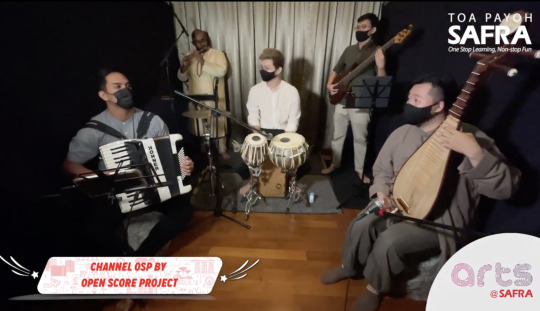
On 21st August 2021, our performance for National Day 2021 by SAFRA Toa Payoh was casted via facebook. This was a digital production and thus we have adopted a different workflow. This segment captures that workflow as well as the lessons learnt along the way.
Rehearsal Phase
We were meeting each other for a rehearsal after a year gap due to the pandemic situation. There were a few glitches and we were finding our way out to the sound. I was struggling to perform at my fullest. But we gathered and revisited some of the compositions we had performed before. With the new addition of the electric bass, the sound of the ensemble is now different and I had to get used to the new sonic environment. With that in mind, we had then decided adhere to the following workflow for the performance.
Setup (Lay Cables, Setup Session for multi-track recording) - Rehearsal of one piece - Record of the rehearsed piece. We followed this workflow for the rest of our repertoire.
The performance can viewed via the link below.
https://www.facebook.com/SAFRAToaPayoh/videos/4484998654885610
Performance Phase
We had performed 5 pieces namely Alisan (Taiwanese Folk Song), Bengawan Solo, Singapore Town, Singai Naadu and We Are Singapore. We had programmed engagement sessions as we introduced our ethnic instruments to our audience.
Challenges:
1. This was the first time I was performing with this ensemble after a long break. I observed how I was taking a long time to getting used to performing live.
2. My pitch control of the flutes was poor especially on the last song. The flute went into the sharper region for the entire song.
3. Poor improvisation segments.
Solutions:
1. I did some reflections on my performance and realised the need for more practice. I started to increase my daily practice. I was so disappointed with my performance and I needed to improve.
2. My pitch control was bad especially for the last component of the song. I planned to spend more time on the flute and explore various other flutes to understand the root cause of the problem.
3. I squeezed in more time to practice improvisation techniques such as the use of melodic motifs to develop my phrases.
Discoveries:
1. I understood the need for practice. As I was performing, I discovered how my fingers were rigid and could not move along the phrases that were available in my mind.
2. I also discovered the wonders of a reflexive auto-ethno approach to study and improve my performances. This method helped me to be retrospective and introspective towards my performances.
0 notes
Text
Week 6: Original Latin Tune
I was working on one of my original tunes for my upcoming recital. It was a contrafact of Besame Mucho. i have situated the google drive link to the melody in this email as well as the lead sheet in this blog.
https://drive.google.com/drive/folders/1JY0X237Modbq-tyQ700Lbu86-Zv4u-3f?usp=sharing
The lead sheet for my composition, Beyond Me is located below for reference. These documents will be passed on to my musicians during rehearsal sessions in November 2021 for my recital.
After setting the melody, I was working on the chord progression (Harmonic Minor Scales)
- I have planned to adopt the following strategies to better handle the improvisation segment of this song. I will be transcribing the solos of ____________________ . The transcription of that solos is located below.
- I will be using some of these patterns and approaches during my performance as well as in my practice sessions in the upcoming week.
I have located a video of my full performance of Beyond Me in this google drive link.
I have also started to follow a practice regime breaking them into 3 sections:
1. Flute Techniques (Tone Building, Dexterity and Tonguing)
2. Musicality Development (Singing Chord Tones, Solfeges and Keys Practice)
3. Music System Development (Practicing Varnams and Memorising Jazz standards for recital)
I spend 4 hours per day on the technical aspect on the flute as such. The amount of hours is an average.
0 notes
Text
Week 5 - Better Improvisations through a better understanding and practice of guide tones (Anthropology)
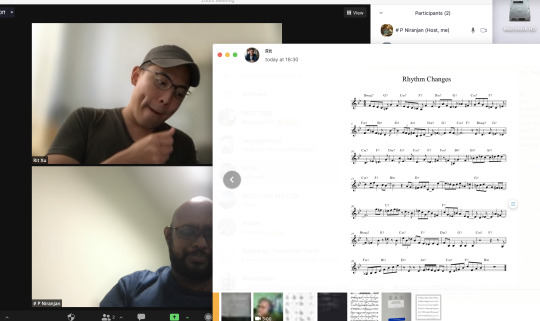
In this class, we had talked about a few aspects of my graduation performance.
We started out by looking at Anthropology closely. The following observation were made.
- Mistakes were made in the melody and more work needs to be out in to memorise the melody.
- The improvisation segments lack jazz idioms and I am still not grasping the concept of guide tones.
We worked on the guide tones. Rit passed me the following Etude for me to practice so I can better my grasp of hearing guide tones during improvisation specific to rhythm changes. The image of the etude is located below.
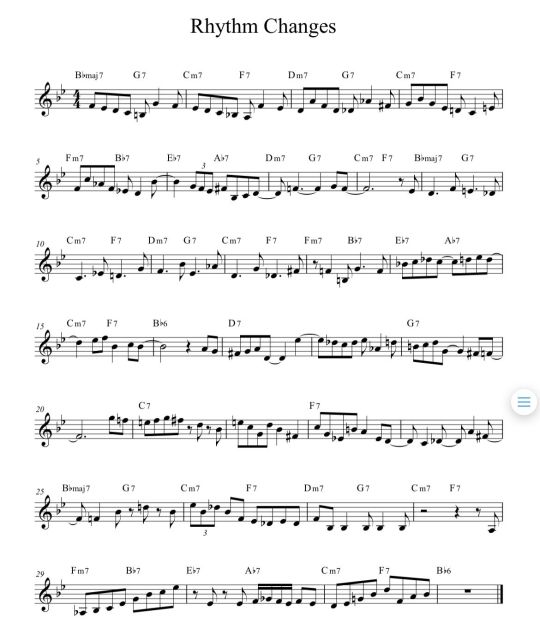
Diagram 1: Etude (Rhythm Changes) given to me by Rit
Step 1: We did a basic harmonic analysis and made sense with the melodic movement. I then mapped the melodic notes to the Indian solfege notes to better relate with the sound of the notes. This transposition is located in the diagram below.
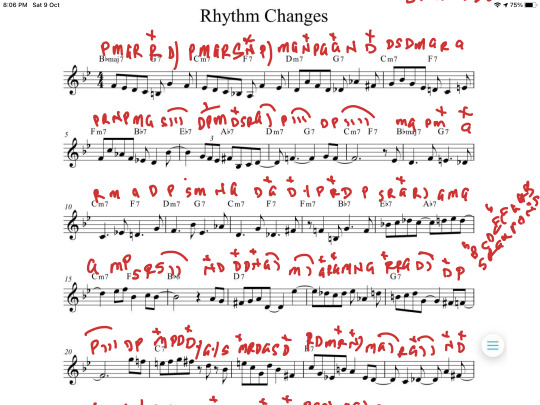
Transposed version of the Etude (Page 1)

Transposed version of the Etude (Page 2)
Step 2: We then started to sing the notes with the use of the keys or the flute. We used the sound to learn the sound and then replicate the sound using our voice. This exercise allowed me to understand the following weaknesses in my musicianship.
- My Intervals are weak and I need to work on them
- I am not able to sing phrases at one go
So we then had set the agenda for the week. The agenda included the following:
1. Work on the Etude and sing along the lines
2. Continue memorising Anthropology
3. Transcribe Chris Potters’ Solo on Anthropology (https://www.youtube.com/watch?v=yw-lH-s7OXg)
4. Complete the Original Tune (Contrafact of Besame Mucho)
0 notes
Text
Week 4: Making Anthropology Better
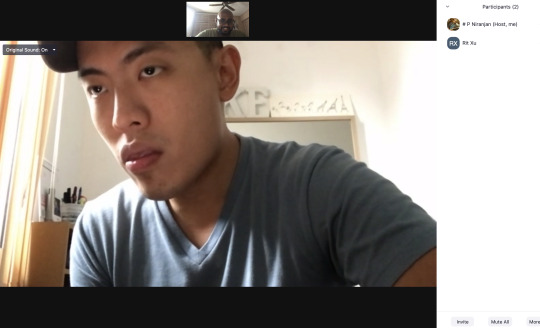
In week 4, we identified areas of improvement for Anthropology and we broke them down into 2 sections.
1. Playing of melody in speed
2. Improvising with Jazz Idioms and the use of guide tones
I had practiced the melody for as many times as possible with the record and also played the melody with just the backing track. This has helped me memorise the repertoire. I am still working on the memory component of this piece.
Following issues were spotted when improvising:
- High notes were not clear on the flute
- I lack the dexterity on the flute
- I do not improvise with available Jazz idioms and I need to understand the concept of guiding tones with respect to the prevailing chord changes which is rhythm changes in this case.
My performance of the song can be seen in the video (google drive link) below taken in week 4.
https://drive.google.com/drive/folders/19ECJ1bjpwrRwhfRgkrV-3whbqxrgifVb?usp=sharing
We also had spoken about existing chord analysis method for my dissertation preparation. Rit recommended Schillinger Theory and the Chord Scale Theory.
- I had researched on those harmonic analysis and were immensely helpful with my literature review for my dissertation.
We had also discussed on having me to revise the songs I had performed over the past 2 years. I have started on collecting the catalogue and will start organising them into forScore and the Spotify links to the songs are located in the links below.
Y1S1: https://open.spotify.com/playlist/1EC9XVELePmkzt92FwjbyM?si=fc30b23dcfdf42e1
Y1S2: https://open.spotify.com/playlist/3BIfOz05JBYucM5PYE4y1X?si=3947cfeb759a4809
Y2S1: https://open.spotify.com/playlist/6XZGR41ys4DeK36M1a9Fhc
Y2S2: https://open.spotify.com/playlist/5Ov9L9pg0MmCVWAMxOndww
0 notes